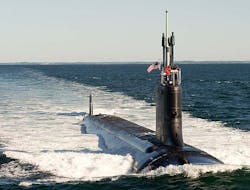L-3 KEO to provide modular masts to hoist sensor payloads of submarines above the water's surface
WASHINGTON – U.S. Navy undersea warfare experts needed non-penetrating sensor masts for the fleet of Virginia-class fast-attack submarines. They found their solution from L-3 KEO (formerly Kollmorgen Electro-Optical) in Northampton, Mass.
Officials of the Naval Sea Systems Command in Washington on Monday announced a $19.3 million contract to L-3 KEO to provide additional Universal Modular Mast (UMM) systems for Navy Virginia-class attack submarines. The UMM serves as a lifting mechanism for Virginia class mast-mounted sensor payloads.
The Virginia-class is one of the first submarines without a traditional optical periscope -- the submarine's traditional optical system that penetrates the vessel's pressure hull, which extends upward to enable commanders of submerged submarines to view the scene on the surface.
Instead, the Virginia-class submarines use bundles of optical fiber that penetrate the submarine's pressure hull only at small points, and do not present the potential single point of failure structural weakness that a traditional periscope and periscope well pose.
Related: Not your grandfather's submarine periscope
The modular masts work with electro-optical, line-of-sight communications, satellite communications (SATCOM), electronic warfare (EW) and underwater sensors. It feeds sensor information to the submarine's combat center, as well as to video monitors located throughout the vessel.
The UMM is reconfigurable with different sensor packages; has a built-in closure doors actuation system; enables the submarine to operate at high speed at periscope depth; offers noiseless raising and lowering control; and offers drop-in and drop-out installation with no alignment required.
The UMM offers significant improvements in environmental performance, integration, stealth, and reliability; offers a versatile design approach that adapts to above-water sensors and antennas; and can life cycle costs; simplifies logistics, support, and ship construction of submarines, company officials say.
L-3 KEO's predecessor, Kollmorgen, installed the first workable periscope aboard a U.S. submarine in 1916, and has been the Navy's primary provider of periscopes and photonics masts since then. L-3 Communications acquired Kollmorgen Electro-Optical (KEO) in early 2012.
Related: Advances in periscope-hunting anti-submarine radar promises to keep the enemy's head down
The UMM, built by L-3 KEO and the company's Italian subsidiary Calzoni SrL in Bologna, Italy can host five different sensor configurations: the photonics mast, the multi-function mast, the integrated electronic mast, the high-data-rate-mast, and the photonics mast variant.
It is a two-stage, non-hull-penetrating, telescoping submarine mast that hoists a variety of different sensors. The Navy's Virginia-class attack subs each have a bank of eight of these sensor masts, while the Ohio-class cruise missile subs each have banks of four UMMs.
On this order L-3 KEO and L-3 Calzoni will do the work in Bologna, Italy, and Northampton, Mass., and should be finished by August 2021. For more information contact L-3 KEO online at www2.l3t.com/keo, L-3 Calzoni at www.calzoni.com, or Naval Sea Systems Command at www.navsea.navy.mil.
Ready to make a purchase? Search the Military & Aerospace Electronics Buyer's Guide for companies, new products, press releases, and videos

John Keller | Editor
John Keller is editor-in-chief of Military & Aerospace Electronics magazine, which provides extensive coverage and analysis of enabling electronic and optoelectronic technologies in military, space, and commercial aviation applications. A member of the Military & Aerospace Electronics staff since the magazine's founding in 1989, Mr. Keller took over as chief editor in 1995.

